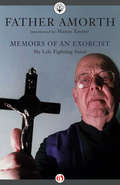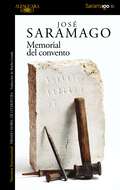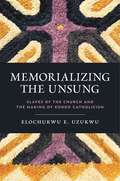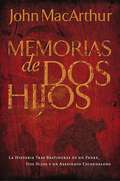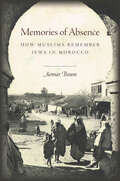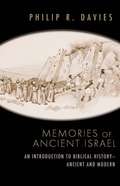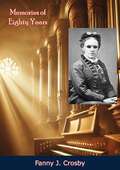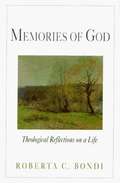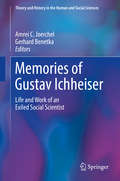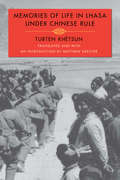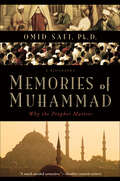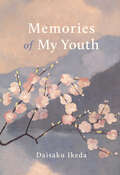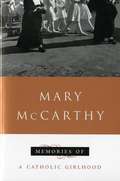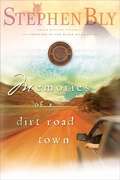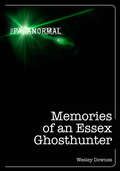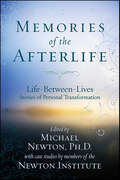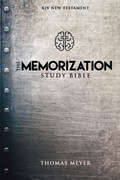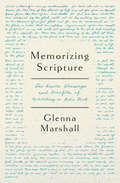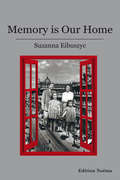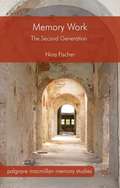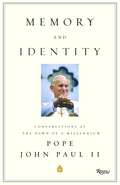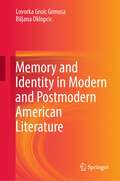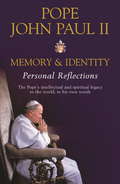- Table View
- List View
Memoirs of an Exorcist
by Marco Tosatti Father Gabriele AmorthFather Amorth was chief exorcist of the Vatican for twenty-five years, but few people know that before he became a priest, Amorth served in the pro-Allied Italian forces during World War II and earned a law degree. He discovered his true calling when he met the exorcist Father Candido. Ever since, he has been face-to-face with the devil every day, relieving thousands of believers of their suffering through religious rites and the power of prayer. Memoirs of an Exorcist recounts Amorth's many impressive stories of healing and faith, as gathered by famed journalist Marco Tosatti.
Memorable Stories and Parables by Boyd K. Packer
by Boyd K. PackerThis volume brings together 26 more of the most memorable stories and parables of President Boyd K Packer. Read and enjoy treasures such as The Mediator, Spiritual Crocodiles, Channeling Your Thoughts, Balm of Gilead, Of Cars and Dates, and more. President Packer follows the Lord's injunction to "Teach ye diligently" and does so in a manner that is clear and lasting. These short stories are great for daily inspiration and will be life lessons that are hard to forget.
Memorial del convento
by José SaramagoEn esta obra José Saramago realiza una incursión en la narrativa histórica. El volumen recorre un periodo de aproximadamente 30 años en la historia de Portugal durante la época de la Inquisición. El planteamiento registra no sólo el hecho histórico, sino que reconstruye la vida popular de la época, en un recorrido por los diferentes pueblos de los alrededores de Lisboa. El rey D. Joâo V necesitaba herederos y, como doña Maria Ana no los concebía, él promete levantar un convento en Mafra a cambio de tener herederos. Simultáneamente, asistimos a la vida cotidiana del pueblo a través de la visión de un soldado que perdió la mano izquierda en la guerra contra los españoles. En un auto de la Inquisición, Baltasar conoce a Blimunda, una mujer con poderes mágicos que ve dentro de las personas, y cuya madre fue desterrada a Angola por tener poderes semejantes. Desafiando los rigores de la religión, ambos se casan mediante un ritualde sangre. Baltasar se convierte en ayudante del padre Bartolomeu, que, bajo la protección del rey, trabajaba en inventar una máquina para volar. La máquina de volar simboliza dos ideales: los cultos, representados por el propio padre Bartolomeu, y los populares, personificados en Blimunda y Baltasar. Una narración directa, sin concesiones, vigorosa y rica. Saramago da al lenguaje de esta novela el tono de las narraciones históricas y realiza con él verdaderos malabarismos sintácticos.
Memorializing the Unsung: Slaves of the Church and the Making of Kongo Catholicism (World Christianity)
by Elochukwu Uzukwu, C.S.Sp.By the time the Capuchins arrived in the seventeenth century, Kongo had been Catholic for nearly two hundred years. The European mission could not be conversion, then, but reinforcement; the Capuchins sought to establish the sacraments and a line to Rome in a lay-led church already suffused with an enduring, creative, and complex theological culture. In Memorializing the Unsung, Elochukwu Uzukwu uses the framework of this “ancient” Kongo Catholicism to explore European dependence on enslaved Kongo Catholics and the unconscionable Capuchin and Spiritan participation in the slave trade at large—a practice denounced by the lone voices of Capuchin Epifanio de Moirans and Spiritan Alexandre Monnet. Reconstructing the church that missionaries and Kongo Catholics built together on the foundations of local religion, Memorializing the Unsung contrasts the dignity denied the Kongo Catholics with the freedom they nonetheless performed. Uzukwu is particularly deft in tracing the agency of Kongo elites and laypeople from the fifteenth century through the nineteenth, carefully evaluating their deliberate engagements with southern Europeans, the role of the maestri (translator-catechists) in guiding the faithful, and the ultimate development of a unique theological vocabulary endorsed by the Kikongo catechism.Without the support and creativity of these unsung lay Catholics across west-central and eastern Africa, Uzukwu shows, the European missions in the region would have failed. Even while enslaved, the Kongo Slaves of the Church and the eastern African Slaves of the Mission served as mediators, co-creators, and reinventors of their world.
Memorias de dos hijos: La historia tras bastidores de un padre, dos hijos y un asesinato escandaloso
by John MacarthurEn Memorias de dos hijos, uno de los maestros de la Biblia más queridos de Estados Unidos le hace profundizar en Lucas 15 como nunca nadie lo ha hecho, revelando apreciaciones perspicaces de la cultura de la época de Jesús con un desenlace inolvidable.La parábola del hijo pródigo (Lucas 15.11-32) se ha predicado desde casi todos los púlpitos del mundo y es conocida por muchos que leen y aprecian la Biblia. La historia es muy poderosa porque representa, en términos claros e inspiradores, nuestra lucha con el pecado, la necesidad de arrepentimiento humilde y la inagotable misericordia y amor del Padre. Lamentablemente, muchos cristianos dirían que no tienen nada nuevo que aprender de esta joya de las Escrituras. Ha perdido su brillo. Pero en Memorias de dos hijos, John MacArthur restaura el resplandor de este pasaje, ofreciendo un fascinante trasfondo histórico y revelando un sorprendente final que los lectores nunca han oído antes.
Memories And Milestones: Stepping Forward By Looking Back
by Jennifer J. Pasqualefrom the cradle to the classroom, from confronting a crisis to conquering the challenge, Memories & Milestones jdresses the issues facing families today. This book is for those who need to step forward in their lives and also for those already on the journey as you see with the author how tragedies become triumphs.
Memories of Absence: How Muslims Remember Jews in Morocco
by Aomar BoumThere is a Moroccan saying: A market without Jews is like bread without salt. Once a thriving community, by the late 1980s, 240,000 Jews had emigrated from Morocco. Today, fewer than 4,000 Jews remain. Despite a centuries-long presence, the Jewish narrative in Moroccan history has largely been suppressed through national historical amnesia, Jewish absence, and a growing dismay over the Palestinian conflict. "Memories of Absence" investigates how four successive generations remember the lost Jewish community. Moroccan attitudes toward the Jewish population have changed over the decades, and a new debate has emerged at the center of the Moroccan nation: Where does the Jew fit in the context of an Arab and Islamic monarchy? Can Jews simultaneously be Moroccans and Zionists? Drawing on oral testimony and stories, on rumor and humor, Aomar Boum examines the strong shift in opinion and attitude over the generations and increasingly anti-Semitic beliefs in younger people, whose only exposure to Jews has been through international media and national memory.
Memories of Ancient Israel: An Introduction to Biblical History--Ancient and Modern
by Philip R. DaviesRecent years have seen an explosion of writing on the history of Israel, prompted largely by definitive archaeological surveys and attempts to write a genuine archaeological history of ancient Israel and Judah.
Memories of Eighty Years
by Fanny J. CrosbyMemories of Eighty Years by Fanny J. Crosby is an inspiring and intimate memoir reflecting on the remarkable life of one of the most beloved hymn writers of the 19th century. Blind since infancy, Crosby rose above her challenges to become a prolific poet, lyricist, and advocate for social reform. In this deeply personal account, she looks back on eight decades of faith, creativity, and service, sharing the experiences and people that shaped her extraordinary journey.The book chronicles Crosby’s life from her childhood in New York, through her education at the New York Institution for the Blind, to her career as a hymn writer and public figure. She offers heartfelt insights into her spiritual development and describes the profound impact of her relationships with family, friends, and influential leaders. Readers will encounter moving stories about her encounters with U.S. presidents, ministers, and fellow musicians, all of whom recognized her unique gifts.Crosby’s reflections are rich with gratitude and humility. She shares the inspirations behind some of her most famous hymns, including “Blessed Assurance” and “To God Be the Glory,” and explains how her faith sustained her through personal hardships, including the loss of loved ones. Beyond her musical achievements, the memoir highlights her work with the poor, homeless, and disabled, revealing her lifelong commitment to serving others.Memories of Eighty Years is more than an autobiography—it is a testimony to the power of faith and perseverance. Crosby’s warmth, humor, and optimism shine throughout, offering readers not only a glimpse into her remarkable life but also timeless lessons in hope, gratitude, and resilience. This book will resonate with those drawn to stories of personal triumph, spiritual inspiration, and the enduring impact of a life devoted to God and humanity.
Memories of God: Theological Reflections on a Life
by Roberta C. BondiWhen the hearing and telling of stories captures our imaginations, we are enabled at the deepest level to take our lives seriously. By envisioning other worlds, we are rendered capable of listening to God and to ourselves, and of growing in God's image. This is how Roberta Bondi comes to tell stories in this book, stories that were formed in a life of prayer. They reflect on life's turning points and how these are made both more difficult and more open to grace by the Christian understandings of naming God as father and mother; the significance of rationality; and the incarnation, crucifixion, and resurrection of Jesus. Bondi discovered that what she had regarded as her personal, private stories were not really so private or idiosyncratic after all when they were seen in the intersection of her beliefs, family experience, and cultural expectations. We are drawn into thelogical reflection on the stories of one woman only to discover there our own stories, our own memories, all stored in the memory of God.
Memories of Gustav Ichheiser: Life And Work Of An Exiled Social Scientist (Theory And History In The Human And Social Sciences Ser.)
by Amrei C. Joerchel Gerhard BenetkaThis book presents an overview of the life and work of Gustav Ichheiser, a social scientist in Vienna during the early 20th century. Gustav Ichheiser, along with many other Austrian Jews of his time, was forced into exile after the rise of National Socialism in Europe. Ichheiser's work is considered an important front runner to the attribution theories. He was one of the first to study the phenomena of social misunderstandings in detail and in relation to concrete problem areas, such as success. The aim of this book is to discuss, on an international level, the importance of Ichheiser's theoretical approaches in his time and their relevance in today's context of social and cultural psychology. In addition, the tragic course of Ichheiser’s biography, an example for many displaced scientists, highlights the importance of bringing a scientist’s work back into the focus of today’s current social scientific setting. Memories of Gustav Ichheiser will be of interest to researchers as well as undergraduate and graduate students in the fields of psychology, social psychology, sociology, and psychiatry.
Memories of Life in Lhasa Under Chinese Rule: An Autobiography
by Tubten KhétsunBorn in 1941, Tubten Khétsun is a nephew of the Gyatso Tashi Khendrung, one of the senior government officials taken prisoner after the Tibetan peoples' uprising of March 10, 1959. Khétsun himself was arrested while defending the Dalai Lama's summer palace, and after four years in prisons and labor camps, he spent close to two decades in Lhasa as a requisitioned laborer and "class enemy." In this eloquent autobiography, Khétsun describes what life was like during those troubled years. His account is one of the most dispassionate, detailed, and readable firsthand descriptions yet published of Tibet under the Communist occupation. Khétsun talks of his prison experiences as well as the state of civil society following his release, and he offers keenly observed accounts of well-known events, such as the launch of the Cultural Revolution, as well as lesser-known aspects of everyday life in occupied Lhasa. Since Communist China continues to occupy Tibet, the facts of this era remain obscure, and few of those who lived through it have recorded their experiences at length. Khétsun's story will captivate any reader seeking a refreshingly human account of what occurred during the Maoists' shockingly brutal regime.
Memories of Muhammad: Why the Prophet Matters
by Omid SafiIn Memories of Muhammad: Why the Prophet Matters, leading Islamic scholar Omid Safi presents a portrait of Muhammad that reveals his centrality in the devotions of modern Muslims around the world. This religious biography offers new insights into Islam, covering such hot button issues such as the spread of Islam, holy wars, the role of women, the significance of Jerusalem, tensions with Jews and Christians, wahabbi Islam, and the role of cyberspace in the evolution of the religion.
Memories of My Youth
by Daisaku IkedaFrom these touching personal essays, written some fifty years ago, wegain not only new insights into Daisaku Ikeda's opposition to war, fascism, andall forces that diminish the value of life but a new appreciationfor this man from humble beginnings whose commitment to peaceremained unbending until his passing in 2023 at age ninety-five.
Memories of a Catholic Girlhood
by Mary MccarthyThis unique autobiography begins with McCarthy's recollections of an indulgent, idyllic childhood tragically altered by the death of her parents in the influenza epidemic of 1918.
Memories of a Dirt Road Town (Horse Dreams Trilogy #1)
by Stephen A. BlyA fifth-grade school teacher in southern Illinois, Develyn Worrell's nightmare begins one summer when she discovers her husband's infidelity. She divorces him without ever telling her twenty-one-year-old daughter why. Although Devvy has a heart change and desires a reconciliation, he dies before she can tell him of her desire. The daughter blames her mother for her father's death. Memories of a Dirt Road Town begins the story the following summer. Brokenhearted about her husband's death and her daughter's decision not to come home for the summer, Devvy decides to find a little dirt road town in Wyoming where she had vacationed as a child. She remembers fondly the sunset and a beautiful roan horse. Upon arrival, Devvy purchases a roan mare and a burro, rents a little cabin, and watches as God brings three very important men into her life.
Memories of an Essex Ghosthunter (The Paranormal)
by Wesley DownesIn this book local pyschic investigator Wesley Downes recounts some of the stories he has been involved with during the 60 years he has lived in Essex. Wesley Downes saw his first ghost in 1946 when he spotted an old school friend walking towards him in a village near Colchester. He later discovered that the friend had died the year before in the D-Day landings. Other stories tell of a missing architect from Chelmsford, a haunted inn in Brentwood, strange events taking place in a house at Harwich and an imbecilic ghost in an art studio in Westcliff-on-Sea.
Memories of the Afterlife: Life-Between-Lives Stories of Personal Transformation
by Michael Newton Ph. D.The author of Journey of Souls and Destiny of Souls presents case studies that highlight the profound impact of spiritual regression on people's lives.These fascinating true accounts from around the world are handpicked and presented by Life Between Lives hypnotherapists certified by the Newton Institute and edited by Dr. Newton. After recalling memories of their afterlife, the people in these studies embarked on life-changing spiritual journeys—reuniting with soul mates and spirit guides, and discovering the ramifications of life and body choices, love relationships, and dreams by communing with their immortal souls. As gems of self-knowledge are revealed, dramatic epiphanies result, enabling these ordinary people to understand adversity in their lives, find emotional healing, realize their true purpose, and forever enrich their lives with new meaning.
Memorization Study Bible, The
by Thomas MeyerTechnology has information at our fingertips. But our relationship with God needs to be one of the heart, not the smartphone. Get engaged with the Word of God in a refreshing and amazing new way! Memorize verses, chapters, and even whole books of the New Testament using the "Bible Memory Man" Prof. Tom Meyer’s powerful techniques that he learned while studying in Jerusalem, Israel. Having memorized 20 complete books of the Bible, Tom shares his helpful tips. Go deeper into Scripture and command a greater knowledge, insight, and understanding of God! Discover memorization techniques used throughout Jewish and Christian history as you unleash the true power of the spoken Word Develop a more intimate relationship with God when you memorize and meditate to keep Scripture in your heart Written by the instructor of the only accredited Bible memorization college course in America
Memorizing Scripture: The Basics, Blessings, and Benefits of Meditating on God's Word
by Glenna MarshallReclaiming the art of Scripture memorizationBible memory has fallen on hard times. It can feel unnecessary since we have Scripture at our fingertips. Or it just feels daunting and unattainable—you know it&’s important, but you&’re just not good at it.Writer, mother, and lover of Scripture Glenna Marshall shows us that to love God with our hearts, we must first love him with our minds. Through Scripture memorization, we begin to meditate on God&’s word. This causes us to think deeply about God, which leads to intimacy and trust. Scripture memory bolsters our daily faith, grows us in discernment, and gives us courage to walk through trials. It arms us with what we need to share the gospel, to fight sin, and to encourage our brothers and sisters in Christ!But how and where do we begin? Glenna gives us practical tools! Even long passages or books of the Bible can be hidden in our hearts with small, doable, daily bites. You&’ll look at how to memorize Scripture in Bible study groups or local church settings as well as with children and friends.Scripture memorization is the path we travel to obey God&’s command to meditate on His Word. You will be transformed as the Bible takes root in your heart. The more we know His Word, the more we will—with the help of the Holy Spirit—be shaped like Jesus. You can do this! Memorizing Scripture shows you how!
Memory Is Our Home: Loss and Remembering: Three Generations in Poland and Russia, 1917-1960s (Edition Noema Ser.)
by Suzanna EibuszycMemory Is Our Home is a powerful biographical memoir based on the diaries of Roma Talasiewicz-Eibuszyc, who was born in Warsaw before the end of World War I, grew up during the interwar period and who, after escaping the atrocities of World War II, was able to survive in the vast territories of Soviet Russia and Uzbekistan.Translated by her own daughter, interweaving her own recollections as her family made a new life in the shadows of the Holocaust in Communist Poland after the war and into the late 1960s, this book is a rich, living document, a riveting account of a vibrant young woman's courage and endurance.A forty-year recollection of love and loss, of hopes and dreams for a better world, it provides richly-textured accounts of the physical and emotional lives of Jews in Warsaw and of survival during World War II throughout Russia. This book, narrated in a compelling, unique voice through two generations, is the proverbial candle needed to keep memory alive.
Memory Work: The Second Generation (Palgrave Macmillan Memory Studies)
by Nina FischerMemory Work studies how Jewish children of Holocaust survivors from the English-speaking diaspora explore the past in literary texts. By identifying areas where memory manifests - Objects, Names, Bodies, Food, Passover, 9/11 it shows how the Second Generation engage with the pre-Holocaust family and their parents' survival.
Memory and Identity
by Pope John Paul IIIn this compelling volume, Pope John Paul II speaks for the first time on global politics. He discusses his views on freedom and democracy and speaks about the twentieth century totalitarian ideologies of communism and Nazism. Making an emphatic appeal for mankind to regard freedom "not only as a gift but a task" to be used for the common good, he calls for a dialogue between all the world's civilizations and religions. This inspiring and thought-provoking work is a unique reflection on human life, and will be admired by thinkers of all religions and nationalities.
Memory and Identity in Modern and Postmodern American Literature
by Biljana Oklopcic Lovorka Gruic GrmusaThis book discusses how American literary modernism and postmodernism interconnect memory and identity and if, and how, the intertwining of memory and identity has been related to the dominant socio-cultural trends in the United States or the specific historical contexts in the world. The book’s opening chapter is the interrogation of the narrator’s memories of Jay Gatsby and his life in F. Scott Fitzgerald’s The Great Gatsby. The second chapter shows how in William Faulkner’s Light in August memory impacts the search for identities in the storylines of the characters. The third chapter discusses the correlation between memory, self, and culture in Tennessee Williams’s A Streetcar Named Desire. Discussing Robert Coover’s Gerald’s Party, the fourth chapter reveals that memory and identity are contextualized and that cognitive processes, including memory, are grounded in the body’s interaction with the environment, featuring dehumanized characters, whose identities appear as role-plays. The subsequent chapter is the analysis of how Jonathan Safran Foer’s Everything Is Illuminated deals with the heritage of Holocaust memories and postmemories. The last chapter focuses on Thomas Pynchon’s Against the Day, the reconstructive nature of memory, and the politics and production of identity in Southeastern Europe.
Memory and Identity: Personal Reflections
by Pope Pope John Paul IIA truly historical document that leaves for posterity the intellectual and spiritual teachings of His Holiness Pope John Paul IIA truly historical document, Memory and Identity contains Pope John Paul II's personal thoughts on some of the most challenging issues and events of his turbulent times. Pope for over 26 years, he was one of the world's greatest communicators and this moving book provides a unique insight into his intellectual and spiritual journey and pastoral experience. Each chapter suggests the answer to a question which either exercised his mind or which he provoked in discussion with laymen and priests. Using the encounters at his summer residence of Castel Gandolfo where conversations took place with leading intellectuals - philosophers as well as theologians - Pope John Paul II addressed in his book many of the questions which arose from these discussions. Here he leaves for posterity an intellectual and spiritual testament in an attempt to seek the answer to defining problems that vex our lives.
